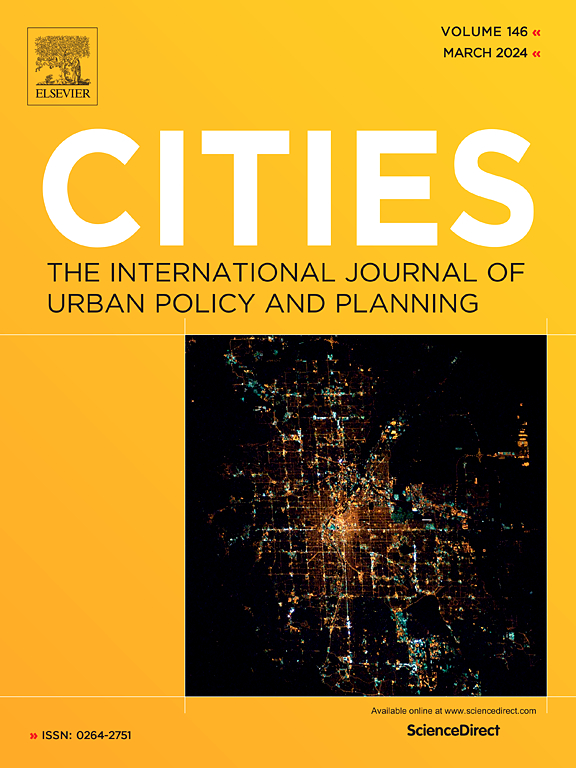城市形态与能源自给:全球八个城市住宅街区的比较研究
IF 6
1区 经济学
Q1 URBAN STUDIES
引用次数: 0
摘要
随着全球气候变化的加剧和能源资源的减少,住宅能源消耗成为一个严峻的挑战。虽然在了解零能耗住区设计中的城市形态和气候因素方面取得了进展,但跨不同文化、地理和气候区域的综合跨语境分析仍然有限。这项研究考察了海牙、新加坡、塔林、柏林、蒙特利尔、维也纳、万塔和苏黎世八个城市的住宅街区,这些城市跨越了温带海洋性、热带雨林和湿润大陆性气候。利用Urban modeling Interface和Rhino等建模翻译工具,结合多元回归分析、递归特征消除(RFE)和随机森林算法等方法,研究分析了这8个城市240个区的12个形态指标。形态指标为自变量,能源自给率为因变量,同时考虑地理和气候因素。结果表明,建筑高度和体积是决定能源自给自足的关键,特别是在塔林和万塔等北部城市,优化的城市形态可以大大提高能源效率。相比之下,尽管柏林、维也纳和苏黎世等中欧城市的光伏条件有利,但能源自给率较低,这主要是由于当前城市形态的限制。对于新加坡来说,优化建筑形状系数和入住率对于提高能源自给自足至关重要。本研究引入了一个新的评估框架,以评估和优化居住区实现近零能耗的全球潜力,强调城市形态和气候之间的复杂相互作用。本文章由计算机程序翻译,如有差异,请以英文原文为准。

Urban morphology and energy self-sufficiency: A comparative study of residential blocks in eight global cities
As global climate change intensifies and energy resources dwindle, residential energy consumption becomes a critical challenge. While progress has been made in understanding urban morphology and climate factors in zero-energy residential block design, comprehensive cross-contextual analysis across diverse cultural, geographical, and climatic regions remains limited. This study examines residential blocks in eight cities—The Hague, Singapore, Tallinn, Berlin, Montreal, Vienna, Vantaa, and Zurich—spanning temperate oceanic, tropical rainforest, and humid continental climates. Using modeling translation tools such as Urban Modeling Interface and Rhino, alongside methods like multiple regression analysis, recursive feature elimination (RFE), and random forest algorithms, the study analyzes 12 morphological indicators from 240 districts in these eight cities. Morphological indicators serve as independent variables, while energy self-sufficiency rates are the dependent variable, with geographical and climate factors also considered. The results reveal that building height and volume are pivotal in determining energy self-sufficiency, particularly in northern cities like Tallinn and Vantaa, where optimized urban morphology can substantially enhance energy efficiency. In contrast, despite favorable photovoltaic conditions in Central European cities such as Berlin, Vienna, and Zurich, lower energy self-sufficiency rates are observed, mainly due to the constraints imposed by current urban morphology. For Singapore, optimizing the building shape coefficients and occupancy rates is essential for improving energy self-sufficiency. This study introduces a novel evaluation framework to assess and optimize the global potential of residential districts for achieving near-zero energy consumption, emphasizing the complex interplay between urban morphology and climate.
求助全文
通过发布文献求助,成功后即可免费获取论文全文。
去求助
来源期刊

Cities
URBAN STUDIES-
CiteScore
11.20
自引率
9.00%
发文量
517
期刊介绍:
Cities offers a comprehensive range of articles on all aspects of urban policy. It provides an international and interdisciplinary platform for the exchange of ideas and information between urban planners and policy makers from national and local government, non-government organizations, academia and consultancy. The primary aims of the journal are to analyse and assess past and present urban development and management as a reflection of effective, ineffective and non-existent planning policies; and the promotion of the implementation of appropriate urban policies in both the developed and the developing world.
 求助内容:
求助内容: 应助结果提醒方式:
应助结果提醒方式:


